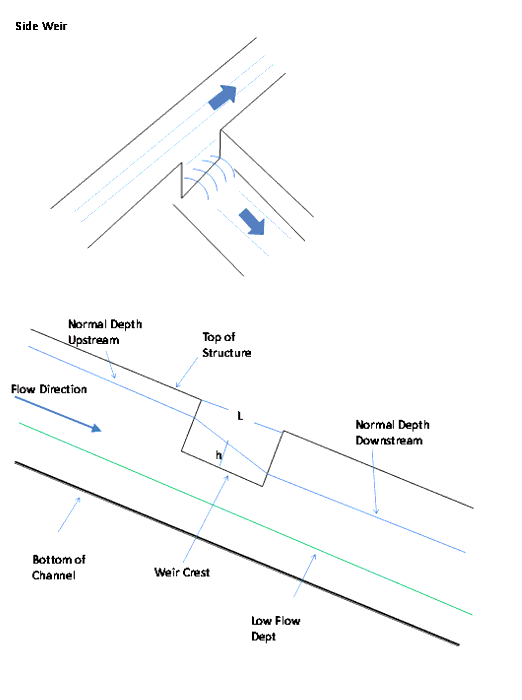| Product(s): |
SewerGEMS, CivilStorm |
| Version(s): |
CONNECT Edition, V8i |
| Area: |
Modeling |
Problem
I have used the "Side Weir" option in a weir conduit control structure, but it does not appear to be discharging weir outflow away from my pipe - the flow continues downstream.
What is the right way to model a side weir conduit control structure that diverts outflow when the water level reaches the weir crest?
Background
Side weirs or overflow weirs are used to divert extra high flows to overflow waterways. Typically a side weir is a weir parallel to the main sewer pipe and with enough high crest elevation to prevent any discharge of dry-weather flow, but it is also low and long enough to discharge required excess of wet weather flow. Another example of a side weir is the emergency overflow weir or spillway at the top of a detention pond.

Solution
All conduit control structures are always simulated as being in series (in-line) with the conduit. So, to model a side weir (that diverts flow away), you'll need to lay out a conduit at a tee (perpendicular) with the main line, and model the side weir as a start control structure on that conduit. To do this set the property of the conduit to "Has Start Control Structure?" (or "Has Stop Control Structure?") to 'True' and create the control structure. It should look like the drawing below in the display pane:

Side Weir Example - saved in CONNECT Edition.zip
Specifying "side weir" vs. "inline weir" changes the available input and the way in which the weir equation is calculated. The side weir option is appropriate for your situation, but you'll still need to direct the outflow appropriately.
The flow and head for a side weir are determined as:
Q = C L h5/3
The units on the weir discharge coefficient are ft1/3/s when flow is in cfs, and L and h are in ft.
See Also
Using Start and Stop Control Structures for conduits and channels
DIVERSION MODELING (forum question)
Side weir is not functioning